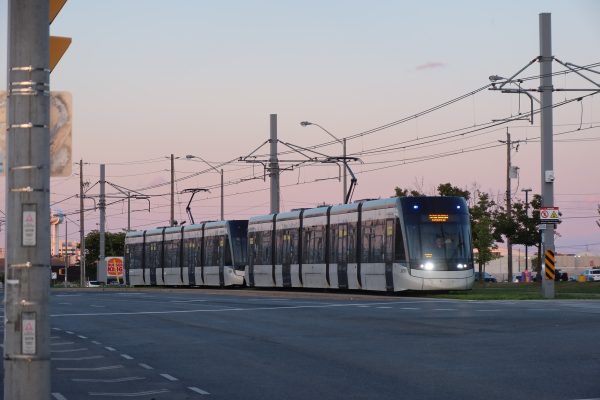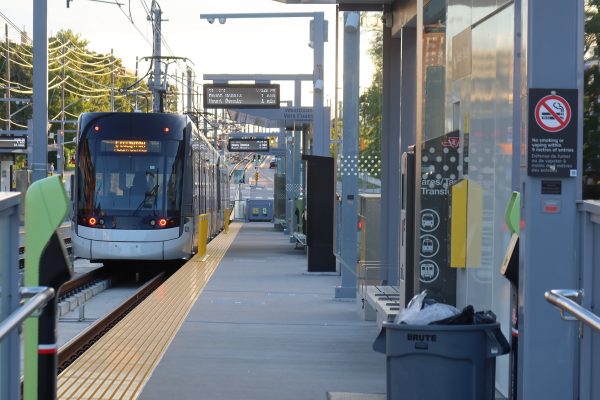As befits a fall when the Blue Jays have again become contenders, the $10 billion-plus question hanging over the soon-to-be-opened Crosstown LRT is whether it will attract riders.
We built it, but will they come?
It’s been a very long time since a major trunk rapid transit line opened in Toronto — arguably 1978, when the Spadina subway extension, up to Wilson, went into service, running for about half its length in the middle of a highway.
Yet the Crosstown’s true predecessor is the Bloor-Danforth subway, which opened almost exactly 60 years ago, replacing buses and streetcars. But it has never fully realized its potential because the city (and the pre-amalgamation municipalities) balked at adding the kind of density around the stations that would have optimized the use of the line.
Fast, or maybe I should say, slow, forward to today: Metrolinx’s exhaustive testing of the Crosstown is, in part, about avoiding the disastrous opening of the Ottawa LRT, which failed almost immediately, and forced the provincial government to hold an inquiry about the causes. When the service finally goes on line, Metrolinx is said to be planning some kind of launch promotion, which will be supported by the city (details so far are scant).
So, yes, making a good first impression for a city-defining piece of infrastructure is crucial. What I’m wondering about is how, or whether, the city and the TTC are going to build on the Crosstown’s technical reliability and the day one festivities in order to make it part of Torontonians’ travel habits. I’m not convinced that merely throwing open the (fare) gates will do the trick.
The TTC isn’t planning any kind of marketing campaign to promote the Crosstown and position this hugely expensive project as a new way of getting around, beyond incorporating it into the route-planning app and making service adjustments, about which more in a moment.
I’d argue, however, that the city and/or the TTC should take this historic juncture to market the heck out of the Crosstown, because, well, field of dreams.
As happened after the York University subway station opened, some commuters will be more than happy to switch from their existing bus routes, but not all of them. (The TTC this week will begin phasing in service changes for the routes that intersect or run parallel to the Crosstown, aka. Line 5.) For those who live close to a bus stop situated between LRT stations, there will be an extra step, and potential delay, associated with transferring to the Crosstown, which means the TTC should be going out of its way to demonstrate the benefits.
The TTC, per Steve Munro’s recent. blog post, unveiled extensions to several north-south bus routes so they intersect with the Crosstown — a set of moves that build on the agency’s well-known talent for connecting bus travellers to rapid transit lines.
Yet it seems to me the city/TTC could go beyond the more mechanical aspects of tying Line 5 into the city’s bus network and online information sources. For over a decade, the Crosstown has existed in the minds of Torontonians first as a massive inconvenience and more recently as the punchline of a terrible infrastructure joke. Renaming it — Line 5, consistent with the TTC’s efforts to use nomenclature to depoliticize transit construction — will only go so far in erasing that bad taste.
Going beyond whatever Metrolinx serves up for the opening, the city/TTC should spend several months, or maybe more, loudly touting the benefits of using this new infrastructure — in effect, by putting suggestions in the minds of Torontonians about how they might use the line. Obviously, there are countless answers to that question, but that doesn’t mean the city/TTC shouldn’t market potential uses, e.g., how Weston residents might take it, and then Line 1 (Spadina), to get to a ball game.
In addition, the new stations offer a host of potential destination marketing opportunities. The TTC and/or the city could partner with, for instance, Eglinton-based BIAs, e.g., Little Jamaica, or other cultural/recreational destinations on the corridor to encourage Torontonians to use the Crosstown. The TTC should also be using house ads and transit vehicle wraps to further raise awareness about the Crosstown in other parts of the city.
None of this will happen by itself, or for free.
Should the TTC spend money on making, say, a year-long push to market the Crosstown? Absolutely. Unlike the original Spadina extension, the Crosstown’s route does abut neighbourhoods that have, or almost have, the density needed to support rapid transit. Yet there will be an extended ramp up period. From a strictly cost-benefit perspective, it makes sense for the city to advertise this service as loudly as possible in order to attract net new riders ASAP and thus reduce the Crosstown’s short-term impact on the TTC’s operating shortfall.
All of this is about the immediate future, needless to add. Further out, the city will be looking at add significant amounts of density around most of the Crosstown stations, and there’s now new zoning in place to enable that kind of development. Yet with the dramatic slowing of the condo market, we’ll likely have to wait for a long time to see the kind of intensification that has been envisioned for large former mall and industrial parcels along Eglinton east and west, and in specific areas like the Golden Mile.
A major rapid transit line is never about the short term, and I’m under no illusions that the Crosstown will be packed anytime soon. Yet Toronto transit planners can think back to the notoriously slow starts for the original Spadina extension and, much later, the Sheppard subway stub, to search for relevant learnings.
Neither are exact analogies, but we ought to know by now that the city, the TTC and destination institutions can’t take new riders for granted.
The big dreams that get projects like the Crosstown funded and built are politically necessary. But on the eve of the opening pitch, they’re definitely not sufficient.







5 comments
Here’s an idea. Apply a short term, but punitive parking levee in the city core and along the line. Ramp it up over the course of a week or two, then ramp it back down to where it was over the next two weeks.
Encourage more commuters to consider trying the new service to save a few dollars during this time.
Or, as Toronto is so good at anyway, don’t clear any snow off the roads. Though, the sidewalks would need clearing which would be a new thing for the city to learn.
A factor I didn’t see mentioned in the article is how fast, frequent, and reliable the service will be. I live next to Eglinton and watch test run LRT vehicles pass by every day. The amount of waiting they spend on the traffic light alone makes me believe the travel times will be frustratingly slow. I fear we will soon find out we blew 12 years and $10+ billion on a glorified streetcar.
It appears that my bus, the Lawrence 54, will take me to the re-christened Don Valley station when Line 5 eventually opens. I fear every time I make the trip I’ll be reminded of the outrageously corrupt closure of the Ontario Science Centre. Depressing.
At least Eglinton was in the 1957 plan, and what we’re just soon going to get at least runs in a straight line, relatively good transit and cheaper than the zig/zag through the core, which is the idea for the OL, a version of which was also in the 1957 plan, though twice as long and likely far more effective at Relief, since it went long in to Etobicoke to c. Islington, and also had the longer north/sough axis on Donlands to Eglinton.
Maybe the TTC/City is going slow on hype, because there’s not any due date for opening, and vexing the province by suggesting it’ll make a difference for transit users and the City may vex the carservatives.
And although this was begun under the Wynne Liberals, it’s seems so ‘off’ that in all likelihood, ALL of the major transit projects of the Ford government should not have been let go ahead, as they all seem to be devolving to boondougles.
Pardon second comment, but it’s in the news again, oops, and this video just came to my attention, and haven’t yet seen it, but it seems good, done by Andriyas Redel, half-hour.
https://www.youtube.com/watch?v=m_YZsX0iGeQ